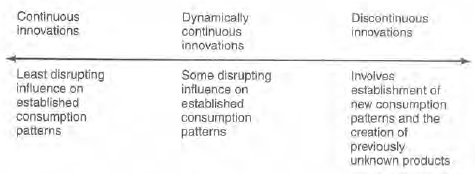There are a variety of ways that products can be classified as new from the perspective of the consumer. Degree of consumption modification and task experience serve as two bases for classification. Robertson provides an insightful model when he suggests that new products may be classified according to how much behavioral change or new learning is required by the consumer in order to use the product.10
The continuum proposed by Robertson and shown in Figure 7.5 depicts the three primary categories based on the disrupting influence the use of the product has on established consumption patterns. It is evident that most new products would be considered continuous innovations. Annual model changes in automobiles, appliances, and sewing machines are examples. Portable hair dryers, diet soda, and aerobic dance CDs reflect products in the middle category. True innovations are rare.

Although conceptualizing new products in terms of how they modify consumer consumption patterns is useful, there is another basis for classification. New task experience can also be a criterion. An individual may live in a house for several years without ever having to repair a broken window. One day a mishap occurs, and Mr. Smith is forced to go to the hardware store to buy the necessary supplies required to install a new window pane. As he has no experience at all with this task, all those products are new to Mr. Smith. The glazing compound, the new glass and molding, and metal tacks, as well as the appropriate tools, are as new to Mr. Smith as a home computer. Using the model proposed by Robertson, products can also be placed on a continuum according to degree of task experience. Clearly, a product that has existed for a great many years, such as a carpenter's level, may be perceived as totally new by the person attempting to build a straight wall. In this case, newness is in the eye of the beholder.
The obvious difficulty with this classification is that it tends to be person-specific. Just because replacing a new washer in your bathroom faucet constitutes a new product for you does not mean it is a new product for me. However, it is conceivable that marketing research would show that for certain types of products, large groups of people have very limited experience. Consequently, the marketing strategy for such products might include very detailed instructions, extra educational materials, and sensitivity on the part of the sales clerk to the ignorance of the customer.
Another possible facet of a new task experience is to be familiar with a particular product but not familiar with all of its functions. For example, a homemaker may have a microwave oven which she uses primarily for reheating food items and making breakfast foods. Suppose that one afternoon her conventional oven breaks and she must deliver several cakes she has donated to a church bazaar. Unfortunately, she has not baked them yet and is forced to use her microwave, a brand-new task.
- 5048 reads






